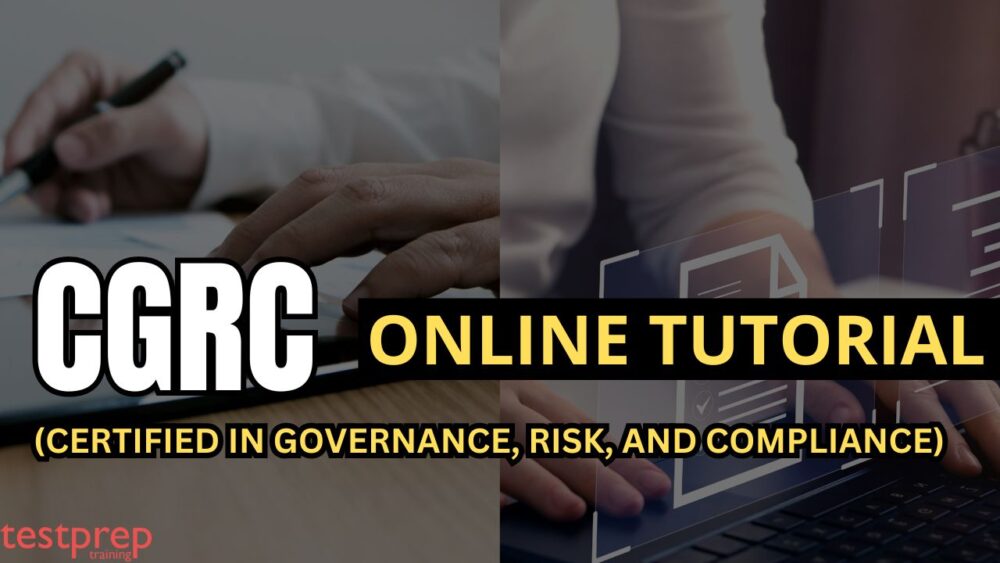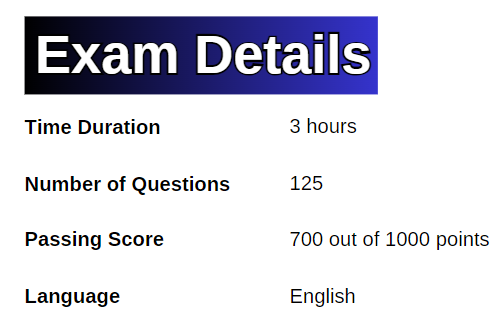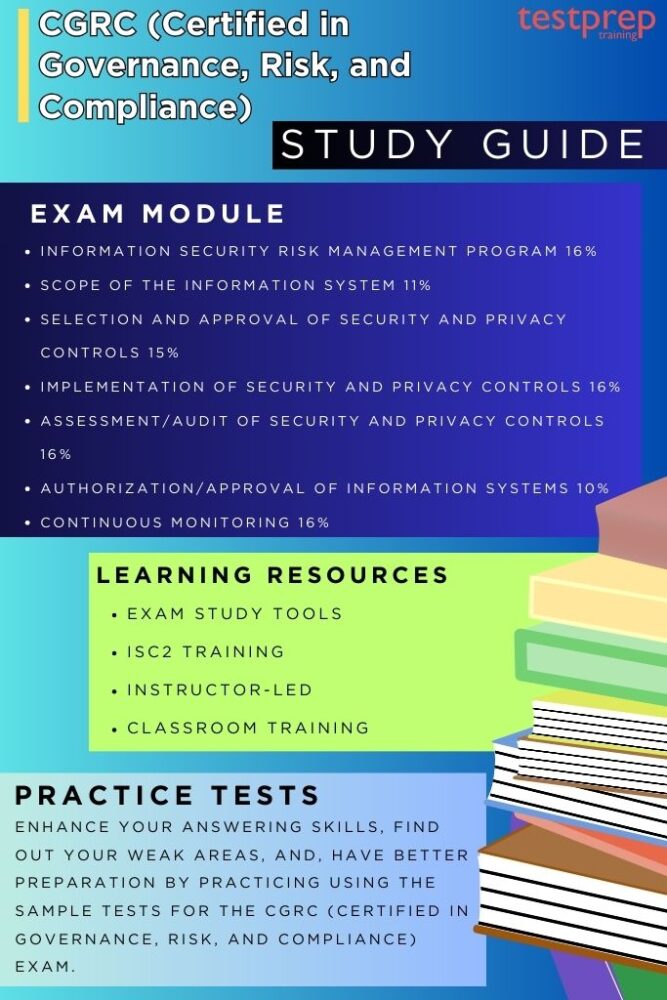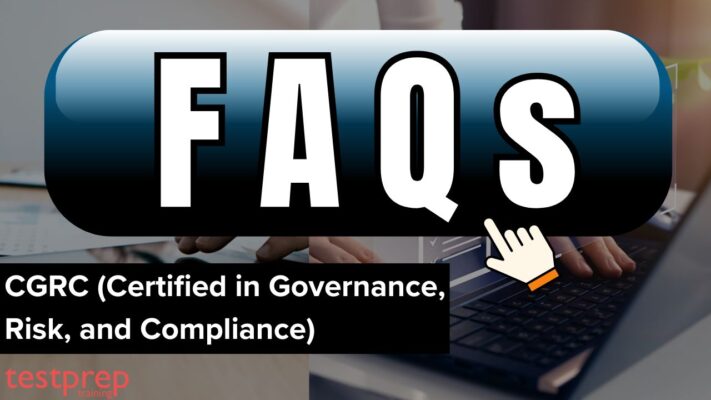CGRC (Certified in Governance, Risk, and Compliance) Exam

The Certified in Governance, Risk and Compliance (CGRC) exam is designed for IT professionals interested in organizational governance, risk management, and compliance. The CGRC Common Body of Knowledge (CBK) covers a wide range of topics, ensuring its relevance across various areas within the field of information security.
Target Audience:
CGRC certification is particularly suitable for professionals in IT, information security, and information assurance fields, specifically those engaged in Governance, Risk, and Compliance (GRC) responsibilities. This includes individuals who seek to comprehend, utilize, and/or execute risk management protocols for IT systems within their respective organizations. Such roles may include:
- Cybersecurity Auditor
- Cybersecurity Compliance Officer
- GRC Architect
- GRC Manager
- Cybersecurity Risk & Compliance Project Manager
- Cybersecurity Risk & Controls Analyst
- Cybersecurity Third-Party Risk Manager
- Enterprise Risk Manager
- GRC Analyst
- GRC Director
- Information Assurance Manager
Experience Requirements:
Candidates should have at least two years of combined full-time experience in any of the seven domains outlined in the current CGRC Exam Outline. Part-time employment and internships can also be considered for meeting this experience criterion.
Exam Details

The Certified in Governance, Risk and Compliance (CGRC) Exam is a three-hour exam and comprises 125 multiple-choice items, with a passing grade set at 700 out of 1000 points. The exam is conducted in English and administered at Pearson VUE Testing Centers.
Course Outline
The CGRC Exam covers the following topics:
Domain 1: Understand Information Security Risk Management Program
1.1 – Demonstrate knowledge in security and privacy governance, risk management, and compliance program
- Principles of governance, risk management, and compliance
- Risk management and compliance frameworks using national and international standards and guidelines for security and privacy requirements (e.g., National Institute of Standards and Technology (NIST), cybersecurity framework, Control Objectives for Information and Related Technology (COBIT), International Organization for Standardization/International Electrotechnical Commission (ISO/IEC))
- System Development Life Cycle (SDLC) (e.g., requirements gathering, design, development, testing, and operations/maintenance/disposal)
- Information lifecycle for each data type processed, stored, or transmitted (e.g., retaining, disposal/destruction, data flow, marking)
- Confidentiality, integrity, availability, non-repudiation, and privacy concepts
- System assets and boundary descriptions
- Security and privacy controls and requirements
- Roles and responsibilities for compliance activities and associated frameworks
1.2 – Demonstrate knowledge in security and privacy governance, risk management and compliance program processes
- Establishment of compliance program for the applicable framework 1.3 – Understand regulatory and legal requirements
1.3 – Demonstrate knowledge of compliance frameworks, regulations, privacy, and security requirements
- Familiarity with compliance frameworks (e.g., International Organization for Standardization/International Electrotechnical Commission (ISO/IEC), Federal Risk and Authorization Management Program (FedRAMP), Payment Card Industry Data Security Standard (PCI-DSS), Cybersecurity Maturity Model Certification)
- Familiarity with other national and international laws and requirements for security and privacy (e.g., Federal Information Security Modernization Act (FISMA), Health Insurance Portability and Accountability Act (HIPAA), executive orders, General Data Protection Regulation (GDPR))
Domain 2: Learn about the Scope of the System
2.1 – Define the system
- System name and scope documented
- System purpose and functionality
2.2 – Determine security compliance required
- Information types processed, stored, or transmitted
- Security objectives outlined for each information type based on national and international security and privacy compliance requirements (e.g., Federal Information Processing Standards (FIPS), International Organization for Standardization/International Electrotechnical Commission (ISO/IEC), data protection impact assessment)
- Risk impact level determined for system based on the selected framework
Domain 3: Selection and Approval of Framework, Security, and Privacy Controls
3.1 – Identify and document baseline and inherited controls
3.2 – Select and tailor controls to the system
- Determination of applicable baseline and/or inherited controls
- Determination of appropriate control enhancements (e.g., security practices, overlays, mitigating controls)
- Specific data handling/marking requirements identified
- Control selection documentation
- Continued compliance strategy (e.g., continuous monitoring, vulnerability management)
- Control allocation and stakeholder agreement
Domain 4: Implementation of Security and Privacy Controls
4.1 – Develop implementation strategy (e.g., resourcing, funding, timeline, effectiveness)
- Control implementation aligned with organizational expectations, national or international requirements, and compliance for security and privacy controls
- Identification of control types (e.g., management, technical, common, operational control)
- Frequency established for compliance documentation reviews and training
4.2 – Implement selected controls
- Control implementation consistent with compliance requirements
- Compensating or alternate security controls implemented
4.3 – Document control implementation
- Residual security risk or planned implementations documented (e.g., Plan of Action and Milestones (POA&M), risk register)
- Implemented controls documented consistent with the organization’s purpose, scope, and risk profile (e.g., policies, procedures, plans)
Domain 5: Assessment/Audit of Security and Privacy Controls
5.1 – Prepare for assessment/audit
- Stakeholder roles and responsibilities established
- Objectives, scope, resources, schedule, deliverables, and logistics outlined
- Assets, methods, and level of effort scoped
- Evidence for demonstration of compliance audited (e.g., previous assessments/audits, system documentation, policies)
- Assessment/audit plan finalized
5.2 – Conduct assessment/audit
- Compliance capabilities verified using appropriate assessment methods: interview, examine, test (e.g., penetration, control, vulnerability scanning)
- Evidence verified and validated
5.3 – Prepare the initial assessment/audit report
- Risks identified during the assessment/audit provided
- Risk mitigation summaries outlined
- Preliminary findings recorded
5.4 – Review initial assessment/audit report and plan risk response actions
- Risk response assigned (e.g., avoid, accept, share, mitigate, transfer) based on identified vulnerabilities or deficiencies
- Risk response collaborated with stakeholders
- Non-compliant findings with newly applied corrective actions reassessed and validated
5.5 – Develop final assessment/audit report
- Final compliance documented (e.g., compliant, non-compliant, not applicable)
- Recommendations documented when appropriate
- Assessment report finalized
5.6 – Develop risk response plan
- Residual risks and deficiencies identified
- Risk prioritized
- Required resources identified (e.g., financial, personnel, and technical) to determine time required to mitigate risk
Domain 6: System Compliance
6.1 – Review and submit security/privacy documents
- Security and privacy documentation required to support a compliance decision by the appropriate party (e.g., authorizing official, third-party assessment organizations, agency) compiled, reviewed, and submitted
6.2 – Determine system risk posture
- System risk acceptance criteria
- Residual risk determination
- Stakeholder concurrence for risk treatment options
- Residual risks defined in formal documentation
6.3 – Document system compliance
- Formal notification of compliance decision
- Formal notification shared with stakeholders
Domain 7: Compliance Maintenance
7.1 – Perform system change management
- Changes weigh the impact to organizational risk, operations, and/or compliance requirements (e.g., revisions to baselines)
- Proposed changes documented and approved by authorized personnel (e.g., Change Control Board (CCB), technical review board)
- Deploy to the environment (e.g., test, development, production) with rollback plan
- Changes to the system tracked and compliance enforced
7.2 – Perform ongoing compliance activities based on requirements
- Frequency established for ongoing compliance activities review with stakeholders
- System and assets monitored (e.g., physical and logical assets, personnel, change control)
- Incident response and contingency activities performed
- Security updates performed and risks remediated/tracked
- Evidence collected, testing performed, documentation updated (e.g., service level agreements, third party contracts, policies, procedures), and submission/communication to stakeholders when applicable
- Awareness and training performed, documented, and retained (e.g., contingency, incident response, annual security and privacy)
- Revising monitoring strategies based on updates to legal, regulatory, supplier, security and privacy requirements
7.3 – Engage in audits activities based on compliance requirements
- Required testing and vulnerability scanning performed
- Personnel interviews conducted
- Documentation reviewed and updated
7.4 – Decommission system when applicable
- Requirements for system decommissioning reviewed with stakeholders
- System removed from operations and decommissioned
- Documentation of the decommissioned system retained and shared with stakeholders
FAQs: CGRC (Certified in Governance, Risk, and Compliance) Exam
ISC2 Code of Ethics and Privacy Policy
For the certification exam, ISC2 covers various Codes of Ethics and privacy policy. This includes:
Every information security expert certified by ISC2 understands that certification is a privilege that necessitates both earning and maintaining. All ISC2 members must pledge full support to the ISC2 Code of Ethics Canons, which include:
- Safeguarding society, the common welfare, essential public trust, and confidence in the infrastructure.
- Conducting oneself with honor, integrity, fairness, accountability, and adherence to the law.
- Delivering diligent and proficient service to clients.
- Promoting and safeguarding the integrity of the profession.
ISC2-certified members are required to pay an annual Maintenance Fee (AMF) of $135, payable on the anniversary of their certification date. Regardless of the number of certifications held, members only need to pay a single AMF of $135. For members with multiple certifications, the AMF is due on the anniversary of their earliest certification.
Study Guide CGRC (Certified in Governance, Risk, and Compliance) Exam

1. Understand the Exam Objectives
To adequately prepare for the CGRC Exam, candidates should familiarize themselves with the exam objectives to ensure thorough readiness. This certification validates the expertise of information security professionals who advocate for security risk management to obtain information system authorization in alignment with an organization’s mission and operational needs, as well as legal and regulatory standards. The exam covers various topics, including:
- Information Security Risk Management Program
- Scope of the Information System
- Selection and Approval of Security and Privacy Controls
- Implementation of Security and Privacy Controls
- Assessment/Audit of Security and Privacy Controls
- Authorization/Approval of Information Systems
- Continuous Monitoring
2. CGRC Study Tools and Resources
Achieving success in the Certified in Governance, Risk, and Compliance (CGRC) certification exam showcases your proficiency in diverse risk management frameworks. Confidence on exam day stems from thorough preparation. The CGRC Official Training pathway is a reliable method to position yourself for success. We collaborate with top training providers worldwide to offer you convenient access to Official Training programs developed by ISC2.
3. Use ISC2 Official Training
By opting for Official ISC2 Training, you ensure access to current content that corresponds with the most recent exam domains. Check the training options that suit your requirements and preferred learning approach. Utilize self-study resources or rely on our network of training partners globally to support you throughout your certification endeavor.
- CGRC Online Instructor-Led Training:
- The CGRC Online Instructor-Led Training provides the framework of a traditional classroom experience while allowing for the convenience of remote learning. The course content has been recently revised to correspond with the updated CGRC exam outline. It includes live virtual instruction delivered by an ISC2 Authorized Instructor, a recognized security specialist holding the CGRC certification.
- CGRC Classroom-Based Training:
- The CGRC Classroom Training is conducted in a conventional face-to-face setting, featuring an ISC2-authorized instructor alongside fellow students. This training session offers a thorough examination of information systems security principles and industry standards, encompassing the seven domains outlined in the CGRC Common Body of Knowledge (CBK).
4. Take Practice Tests
Engaging with practice tests for the CGRC exam helps in recognizing both your proficiencies and areas that require enhancement. This evaluation enhances your capacity to handle questions efficiently, potentially refining your time management during the actual exam. For optimal preparedness, it is advisable to undertake these practice tests following the completion of each topic, reinforcing your understanding of the study materials.



